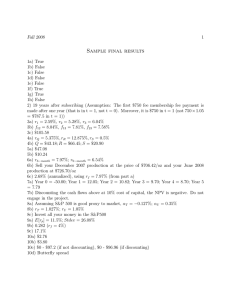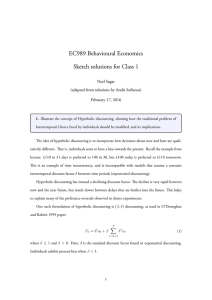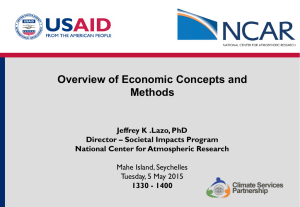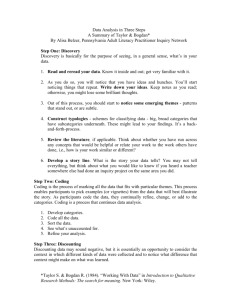Social Discounting and Externalizing Behavior Problems in Boys
advertisement
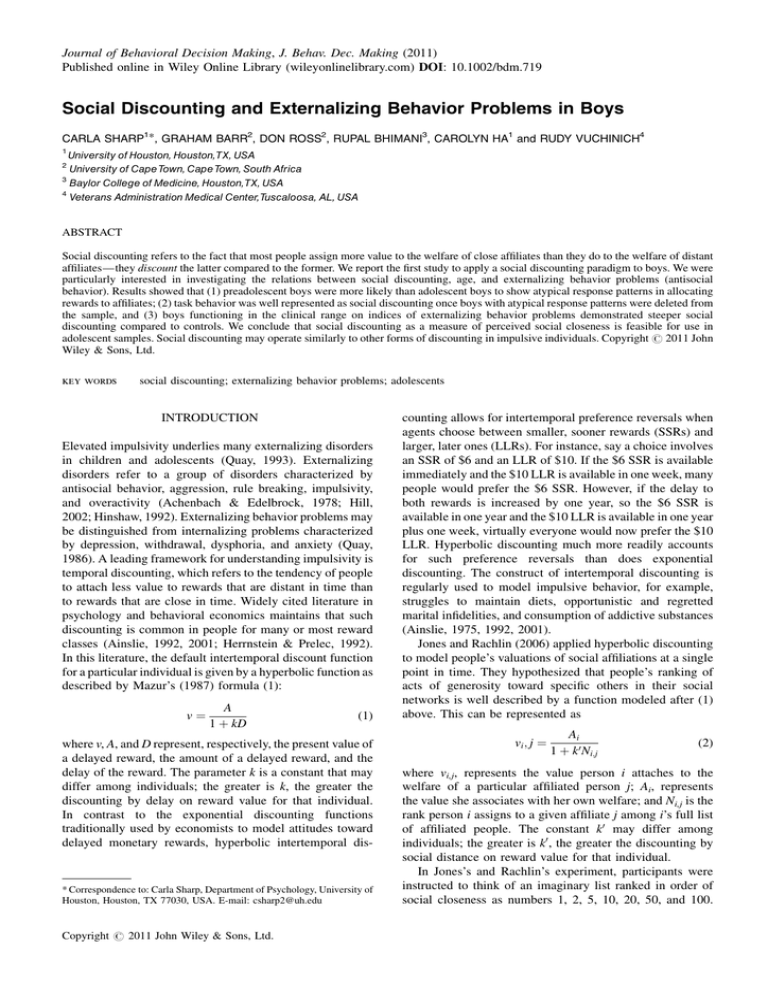
Journal of Behavioral Decision Making, J. Behav. Dec. Making (2011) Published online in Wiley Online Library (wileyonlinelibrary.com) DOI: 10.1002/bdm.719 Social Discounting and Externalizing Behavior Problems in Boys CARLA SHARP1*, GRAHAM BARR2, DON ROSS2, RUPAL BHIMANI3, CAROLYN HA1 and RUDY VUCHINICH4 1 University of Houston, Houston,TX, USA University of CapeTown, CapeTown, South Africa 3 Baylor College of Medicine, Houston,TX, USA 4 Veterans Administration Medical Center,Tuscaloosa, AL, USA 2 ABSTRACT Social discounting refers to the fact that most people assign more value to the welfare of close affiliates than they do to the welfare of distant affiliates—they discount the latter compared to the former. We report the first study to apply a social discounting paradigm to boys. We were particularly interested in investigating the relations between social discounting, age, and externalizing behavior problems (antisocial behavior). Results showed that (1) preadolescent boys were more likely than adolescent boys to show atypical response patterns in allocating rewards to affiliates; (2) task behavior was well represented as social discounting once boys with atypical response patterns were deleted from the sample, and (3) boys functioning in the clinical range on indices of externalizing behavior problems demonstrated steeper social discounting compared to controls. We conclude that social discounting as a measure of perceived social closeness is feasible for use in adolescent samples. Social discounting may operate similarly to other forms of discounting in impulsive individuals. Copyright # 2011 John Wiley & Sons, Ltd. key words social discounting; externalizing behavior problems; adolescents INTRODUCTION Elevated impulsivity underlies many externalizing disorders in children and adolescents (Quay, 1993). Externalizing disorders refer to a group of disorders characterized by antisocial behavior, aggression, rule breaking, impulsivity, and overactivity (Achenbach & Edelbrock, 1978; Hill, 2002; Hinshaw, 1992). Externalizing behavior problems may be distinguished from internalizing problems characterized by depression, withdrawal, dysphoria, and anxiety (Quay, 1986). A leading framework for understanding impulsivity is temporal discounting, which refers to the tendency of people to attach less value to rewards that are distant in time than to rewards that are close in time. Widely cited literature in psychology and behavioral economics maintains that such discounting is common in people for many or most reward classes (Ainslie, 1992, 2001; Herrnstein & Prelec, 1992). In this literature, the default intertemporal discount function for a particular individual is given by a hyperbolic function as described by Mazur’s (1987) formula (1): v¼ A 1 þ kD (1) where v, A, and D represent, respectively, the present value of a delayed reward, the amount of a delayed reward, and the delay of the reward. The parameter k is a constant that may differ among individuals; the greater is k, the greater the discounting by delay on reward value for that individual. In contrast to the exponential discounting functions traditionally used by economists to model attitudes toward delayed monetary rewards, hyperbolic intertemporal dis- * Correspondence to: Carla Sharp, Department of Psychology, University of Houston, Houston, TX 77030, USA. E-mail: csharp2@uh.edu Copyright # 2011 John Wiley & Sons, Ltd. counting allows for intertemporal preference reversals when agents choose between smaller, sooner rewards (SSRs) and larger, later ones (LLRs). For instance, say a choice involves an SSR of $6 and an LLR of $10. If the $6 SSR is available immediately and the $10 LLR is available in one week, many people would prefer the $6 SSR. However, if the delay to both rewards is increased by one year, so the $6 SSR is available in one year and the $10 LLR is available in one year plus one week, virtually everyone would now prefer the $10 LLR. Hyperbolic discounting much more readily accounts for such preference reversals than does exponential discounting. The construct of intertemporal discounting is regularly used to model impulsive behavior, for example, struggles to maintain diets, opportunistic and regretted marital infidelities, and consumption of addictive substances (Ainslie, 1975, 1992, 2001). Jones and Rachlin (2006) applied hyperbolic discounting to model people’s valuations of social affiliations at a single point in time. They hypothesized that people’s ranking of acts of generosity toward specific others in their social networks is well described by a function modeled after (1) above. This can be represented as vi ; j ¼ Ai 1 þ k0 Ni;j (2) where vi,j, represents the value person i attaches to the welfare of a particular affiliated person j; Ai, represents the value she associates with her own welfare; and Ni,j is the rank person i assigns to a given affiliate j among i’s full list of affiliated people. The constant k0 may differ among individuals; the greater is k0 , the greater the discounting by social distance on reward value for that individual. In Jones’s and Rachlin’s experiment, participants were instructed to think of an imaginary list ranked in order of social closeness as numbers 1, 2, 5, 10, 20, 50, and 100. Journal of Behavioral Decision Making Therefore, the 1st person on the list would be the person closest to them (e.g., husband or wife) and the 100th person would be a more distant acquaintance (e.g., cashier at the grocery store). They were then asked whether they would prefer to receive a certain amount of money (e.g., $155) for themselves only (the ‘‘selfish’’ option) or $75 for themselves and $75 for a designated person on their list (the ‘‘share’’ option). The amounts for selfish options descended from $155 to $75 in decrements of $10 (thus each subject imagined nine choices). They were asked to imagine these choices for persons in order of the affiliates they had ranked as numbers 1, 2, 5, 10, 20, 50, and 100 on the list. Jones and Rachlin found that, unsurprisingly, participants were willing to forgo greater amounts of money for the benefit of people with whom they perceived themselves as having closer affiliation. For example, some subjects were willing to forgo the entire $75 for a person high on their list, but only willing to forgo $10 for a person low on their list. Jones and Rachlin (2006) assumed that subjects compared the rewards they received when they chose selfishly with the rewards they gave to others on internally consistent linear scales. The authors then showed that under that assumption, if all choices by all subjects are aggregated, the data best fit a hyperbolic curve (Equation 2). This was reconfirmed in a second study with different subjects using a similar experimental design (Rachlin & Jones, 2008a). Rachlin and Jones (2008a, b) therefore interpreted the choice behavior displayed by their experimental subjects as ‘‘hyperbolic social discounting.’’ A motivation of Rachlin and Jones (2008b) in exploring this phenomenon is their general hypothesis that people comparatively value objects, relationships, and experiences in a way that implies hyperbolic distance measures from reference points. Thus, according to Jones and Rachlin, intertemporal discounting and social discounting—along with discounting of risk—are special cases of a general human disposition to associate greater relative ratios of value to comparisons among higher-valued alternatives than to comparisons among lower-valued alternatives. This would allow for comparisons of relative dispositions to selfish choice between subjects by reference to differences in the values of their personal k0 parameters. That is, a subject with a higher k0 parameter will reduce his generosity as social distance increases at a faster rate than a subject with a lower k0 parameter. A question raised by consideration of this hypothesis is whether there is evidence that it applies to children, who are stereotypically viewed as impulsive by comparison with normal adults. Limited investigations of intertemporal discounting in children have been reported. While most researchers expect discounting to be represented by a hyperbolic discount curve that is comparable in functional form to those of adults, children are also expected to discount delayed rewards more steeply. Indeed, Green, Fry, and Myerson (1994) acquired experimental data showing that Mazur’s formula yielded a close fit to discounting in 12-year-old, while Scheres et al. (2006) showed that younger children (6–11 years old) discounted delayed rewards more steeply than did older children (12–17 Copyright # 2011 John Wiley & Sons, Ltd. years old). Green et al. (1994) also demonstrated steeper k-values for children. Against this background, the main aim of the present study was to investigate whether the social discounting paradigm developed by Jones and Rachlin (2006) could be applied to children and adolescents (aged 8–17) taking into account externalizing behavior problems. First, we determined whether boys’ choices for different affiliate rankings match intuitive expectations about conceptualization of social space on which the Jones and Rachlin paradigm is based. Do boys choose individuals who are indeed close to them in social distance, or do they make choices that suggest difficulty in understanding the abstract idea of social distance? Imagine, for example, that boys consistently assign high ranks to people they see regularly, but with whom they have few or no reciprocal personal interactions, for example, the janitor at school. Second, we investigated whether any unexpected (atypical) patterns in social discounting in boys might be accounted for by age. As observed by Jones and Rachlin, a typical adult pattern of social discounting is choosing the ‘‘share’’ option for closest affiliates, but switching to the ‘‘selfish’’ option at some point down the list as more distant affiliates are considered. Jones’s and Rachlin’s experimental paradigm, however, incorporates features which may be sensitive to developmental effects. It requires participants to hold in mind seven relationships with specific others, by reference to which nine decisions each are made (see Method Section for more detail). It is possible that younger children lack adequate executive functioning (Pennington & Ozonoff, 1996), working memory or abstract thinking capacity to reliably complete the task, and might therefore make random and inconsistent decisions between options. Third, we investigated the extent to which implementation of the Jones and Rachlin paradigm with child and adolescent subjects produces patterns of implied social discounting that resemble Jones’s and Rachlin’s adult data in respect of being well described by Mazur’s formula. Positive findings in this regard would further establish the applicability of the social discounting paradigm to youth. Fourth, we investigated whether steeper social discounting (that is, social discounting best characterized by functions in which the k0 parameter is higher valued) is related to indices of externalizing behavior disorders in boys. Children and adolescents with externalizing problems have a greater preference for small and immediate rewards compared to larger delayed rewards (Barkley, Edwards, Laneri, Fletcher, & Metevia, 2001; Kuntsi, Oosterlaan, & Stevenson, 2001; Schweitzer & Sulzer-Azaroff, 1995; Solanto et al., 2001; Sonuga-Barke, Taylor, Sembi, & Smith, 1992; Tripp & Alsop, 2001; for a review, see Luman, Oosterlaan, & Sergeant, 2005), indicating greater impulsivity in these children. Children and adolescents with externalizing behavior problems have also been shown to have significant social-cognitive deficits (Dodge, 1980, 1993; Sharp, 2008) and problems with empathy (Blair, 1997, 1999). Higher impulsivity and problems in social cognition and empathy would suggest that children functioning in the clinical range on indices of externalizing behavior problems J. Behav. Dec. Making (2011) DOI: 10.1002/bdm C. Sharp et al. Social Discounting and Behavior Problems in Boys might make choices best described by social discounting functions with systematically higher k0 values, compared to children below cut-off. METHOD Participants A sample of 170 boys (2nd to 12th graders) was recruited through community organizations in Houston, Texas. We focused the study on boys because of the known high risk of externalizing behavior problems associated with male gender (Hill, 2002; Moffitt, Caspi, Rutter, & Silva, 2001). The mean age and grade of the sample was 162 months (13.5 years) and 7th grade, respectively, with the youngest aged 8 (n ¼ 1) and the oldest aged 17 (n ¼ 10). Just under half of the boys (48.8%; n ¼ 83) were between ages 8–12. The sample was ethnically representative with socio-economic status estimated to be primarily middle class on the basis of parental education. Parents and children consented in person prior to data collection. IRB approval for the study was obtained. Measures Externalizing behavior problems It is well known that different sources (e.g. parents, peer, and children themselves) often disagree on the presence and severity of problem behaviors (Verhulst & van der Ende, 1992), each contributing valid and unique information (Achenbach, McConaughy, & Howell, 1987; Verhulst & Van der Ende, 1992). Multiple informants are needed to obtain a comprehensive picture of an individual’s functioning (Verhulst & van der Ende, 1992). To this end, we combined three measures of externalizing behavior to include youth self-report, parent-report, and peer nominations. Youth self-report and parent-report. The youth self-report (YSR; Achenbach & Rescorla, 2001) and child behavior checklist (CBCL; Achenbach & Rescorla, 2001) are well established evidence-based assessment instruments (Holmbeck et al., 2008), that assess global and more specific psychopathology among boys ages 6–18 years. The YSR and CBCL assess behavioral and emotional disorders in the past 6 months. The YSR and CBCL each contains 112 problem items, each scored on a 3-point scale 0 (not true), 1 (somewhat or sometimes true), to 2 (very or often true). The YSR and CBCL each yields a T-score of general psychiatric functioning and two broad subscales of externalizing behavior problems and internalizing behavior problems. Achenbach and Rescorla (2001) recommended using a T-score cut-off at or above 65 to separate individuals at higher risk for psychopathology. Prior research indicates this threshold discriminates well between clinical and nonclinical populations (Achenbach & Rescorla, 2001). For the current study, we used T-score of 65 on the externalizing subscale to group boys in above- and below-cut off Copyright # 2011 John Wiley & Sons, Ltd. categories for clinically relevant externalizing behavior problems. Peer nomination as relationally aggressive or prosocial. A peer-nomination instrument developed by Werner and Crick (1999) was used to assess relational aggression and prosocial behavior. The measure consists of 24 items. Seven of the items tap into a relational aggression subscale. This subscale has been found to be highly reliable, with Cronbach’s alpha of 0.87. Nine items tap into a prosocial behavior subscale that has been shown to be highly reliable as well (Cronbach’s alpha ¼ 0.91). Following Werner and Crick (1999), participants were provided with a group membership roster to be used during self-administration of the peer-nomination instrument. For each of the behavioral items, participants were instructed to nominate up to five peers who best fit each description. The number of nominations each participant received from his or her peers was summed for each item and totaled for each subscale. Next, we used the 50th percentile to identify boys above and below the median for relationally aggressive and prosocial nominations. As is often the case with sociometric studies (Cillessen & Bukowski, 2000) many boys were nominated as both prosocial and relationally aggressive, so many boys fell above the 50th percentile for both subscales. For the analyses, we were interested in comparing social discounting in boys who were perceived as ‘‘only prosocial’’ versus boys nominated in both categories. Similarly, we were interested in comparing boys who were ‘‘only relationally aggressive’’ to boys in both categories. Composite measure of externalizing behavior problems. Since normality assumptions for externalizing behavior disorder variables were violated (possibly due to the fact that the sample was drawn from the community), all variables were submitted to a normalizing transformation. A boy was considered to meet criteria for externalizing behavior problems if he were above clinical cut-off for parent- and self-report externalizing problems, considered as ‘‘only relationally aggressive,’’ and not in the ‘‘only prosocial category.’’ Social discounting The social discounting measure used by Jones and Rachlin (2006) was adapted for use in the current study. The top page of the boys’ questionnaire packet informed participants that their answers were anonymous and would remain confidential, that there were no right or wrong answers, and that honest answers were preferred. The instructions were as follows: The following game asks you to imagine that you have made a list of the 100 people closest to you in the world ranging from your dearest friend or relative at position #1 to someone you barely know at #100. The person at number one would be someone you know well and is your closest friend or relative. The person at #100 might be someone you recognize and encounter but perhaps you may not even know their name. You do not have to physically create the list—just imagine that you have done so. J. Behav. Dec. Making (2011) DOI: 10.1002/bdm Journal of Behavioral Decision Making On the next few pages you will be asked to make a series of decisions based on what you prefer. Your choice will always be between A. keeping money for yourself or B. sharing money with someone else Participants were also asked to raise their hands if they needed help. On the first page of the instrument, participants were again reminded of their task: Imagine you made a list of the 100 people closest to you in the world ranging from your dearest friend or relative at #1 to someone you barely know at #100. On each of the seven pages of the measure appeared the following instructions. (We show as an example the instruction applied with respect to the first person on each subject’s list.) Write down the name of the first person on your list. What is the relationship you have to that person (e.g., mom, dad, sister, brother, best friend, boyfriend, girlfriend, etc.)? Now imagine the following choices between an amount of money for you and an amount for the first person (#1) on the list. Circle A or B to indicate which you would choose in EACH line. A. $155 for you alone. A. $145 for you alone. A. $135 for you alone. A. $125 for you alone. A. $115 for you alone. A. $105 for you alone. A. $95 for you alone. A. $85 for you alone. A. $75 for you alone. B. $75 for you and 75 for the first person on the list. B. $75 for you and 75 for the first person on the list. B. $75 for you and 75 for the first person on the list. B. $75 for you and 75 for the first person on the list. B. $75 for you and 75 for the first person on the list. B. $75 for you and 75 for the first person on the list. B. $75 for you and 75 for the first person on the list. B. $75 for you and 75 for the first person on the list. B. $75 for you and 75 for the first person on the list. For all participants, the left column (column A) was identical on all pages. For each participant, the social distance (‘‘first’’ above) of the right column (column B) was the same on a single page, but varied between pages, changing from 1 to 100, in the following increments and order: 1, 2, 5, 10, 20, 50, and 100. That way, participants were indicating how much money they were willing to forgo for themselves alone so they and a person on their list could both receive money. Procedures The social discounting and peer nomination tasks were presented to groups of 5–10 children with three trained experimenters in the room. The small group administration Copyright # 2011 John Wiley & Sons, Ltd. enabled participants to ask clarification questions about the instructions. Trained experimenters took care not to suggest preferred ways of responding to the task. Parents completed the CBCL during the same testing session but in a different room. Data analytic strategy For data analysis, a single crossover point monetary value where participants switched from choosing the option in the A column (the selfish option) to choosing the option in the B column (the share option) was determined for each subject following Jones and Rachlin (2006). The difference between the crossover point value $x: $75 $x $155 (where x varies with social distance point) and $75 was the maximum amount of money a participant would forgo in exchange for $75 to the person at each social distance point on the list. The crossover point was defined as the mean of column A dollar amounts where the switch between columns A and B was made. For example, if a participant chose the ‘‘selfish’’ option at A: $155 and A: $145 and switched to the ‘‘share’’ option at A: $135, the crossover point was calculated to be $140. However, many participants chose the share option even when the alternative was A: $155. In these cases, following Jones and Rachlin (2006), a crossover point was assumed at $160. When a participant chose the selfish option exclusively for a given position on her list, a crossover point was assumed at $70, again after Jones and Rachlin (2006). To arrive at a discount rate for different individuals, formula (2) was fitted to each subject’s crossover point data using a least-squares criterion. In general, that is, the sum of P7 2 squares ð v ^ i;n vi;n Þ was minimized with respect to n¼1 0 both Ai and k for each case, where vi;n is the crossover point at social distance Ni;n . This process generated values of Ai and k0 i for each child. In this particular analysis we assumed that the Ai were constant (at A0 ) across individuals and also assumed that the seven social distances for each individual were the same but that k0 i differs from person to person as usual. We thus estimated a function of the following form, using a least squares criterion as described above: vi;n ¼ A0 1 þ ki0 Nn (3) In order to estimate A0 , we proceeded as follows: we first found the median indifference point for each of the seven social distances; these seven medians were then used to fit the Mazur hyperbolic discounting function to find A and k0 average; the constant A obtained in this (median) case was labeled A0 . We then estimated Equation (3) for each individual i and assuming a constant A (A0) we obtained a k0 i for each individual using a least squares fitting procedure. RESULTS Children’s understanding of social distance, as reflected in choices of people at varying positions An important way of determining whether the social discounting paradigm could usefully be administered to children was to determine whether subjects’ choices for J. Behav. Dec. Making (2011) DOI: 10.1002/bdm C. Sharp et al. Social Discounting and Behavior Problems in Boys Figure 1. Percentage of subjects’ (n ¼ 170) choices of persons to occupy each of the first four social distance points (1st, 2nd, 5th, and 10th) affiliate rankings were intuitively consistent with the expectations underlying Jones’s and Rachlin’s design. As shown in Figure 1, subjects’ choices of persons to occupy each of the first four social distance points mirrored conventional expectations. For example, 36.3% of children designated a parent and 36.8% designated a best friend as first person on the list (i.e., closest in social distance), compared to siblings (9.4%), girlfriends (6.4%), other family members (2.9%) and others (1.8%). In contrast, only 11.7% of children designated a parent as second on the list, with 57.3% designating a friend at this position and 9.4, 6.4, 8.2, and 2.9% of children choosing the other categories of designated persons displayed in Figure 1. The patterns of choices for the fifth and tenth positions on the list remained similar to those of the second position. The relationship between response patterns and age More than half of the sample (66.5%; n ¼ 113) made inconsistent responses with multiple crossover points (randomly switching between ‘‘share’’ decisions and ‘‘selfish’’ decisions regardless of affiliates’ rankings) or ‘‘perverse’’ responses—that is, crossover points in the wrong direction (choosing the ‘‘selfish’’ option for higher-ranked affiliates and ‘‘share’’ options for lower-ranked affiliates). We tested for a relationship between atypical decisionmaking of the kinds described immediately above, and age (n ¼ 170). The results of a chi-square analysis showed that 74% of 8–12 versus 40% of 13–17 years old showed atypical response patterns, thereby demonstrating a significant likelihood for younger children to engage in atypical response patterns, x2(1, N ¼ 170) ¼ 3.59; p ¼ 0.05). Are children’s hypothetical sharing choices with affiliates well described as social discounting? Before plotting subjects’ behavior using formula (2), it was necessary to exclude participants with atypical or inconsistent responses. Criteria for exclusion included multiple crossover points and crossover points in the wrong direction, as described above. Table 1 summarizes the percentage Copyright # 2011 John Wiley & Sons, Ltd. Table 1. Percentage inclusion by age group (exclusion based on multiple switch-over points and switch-over points in the wrong direction; n ¼ 170) Excluded Age Yes No Total 8 Count % within age group 1 100 0 0 1 100 10 Count % within age group 4 100 0 0 4 100 11 Count % within age group 33 82.5 7 17.5 40 100 12 Count % within age group 23 60.5 15 39.5 38 100 13 Count % within age group 21 70.0 9 30.0 30 100 14 Count % within age group 13 68.4 6 31.6 19 100 15 Count % within age group 9 45.0 11 55.0 20 100 16 Count % within age group 4 50.0 4 50.0 8 100 17 Count % within age group 5 50.0 5 50.0 10 100 Total Count % within age group 113 66.5 57 33.5 170 100 J. Behav. Dec. Making (2011) DOI: 10.1002/bdm Journal of Behavioral Decision Making Table 2. Social distances, k0 and R2 (least squares fit) in the case where A is fixed (at A0 on subjects who were included in the study (n ¼ 57; exclusion based on multiple switch-over points and switch-over points in the wrong direction) Social distances Estimates (hyperbolic fit) Subject 1.0 2.0 5.0 10.0 20.0 50.0 100.0 A0 k0 R2 (%) 1 2 3 4 5 6 7 8 9 10 11 12 13 14 15 16 17 18 19 20 21 22 23 24 25 26 27 28 29 30 31 32 33 34 35 36 37 38 39 40 41 42 43 44 45 46 47 48 49 50 51 52 53 54 55 56 57 Average 75 75 25 85 55 85 85 85 55 85 25 85 75 85 15 55 85 55 75 85 85 5 85 75 85 85 85 5 85 25 25 65 85 85 85 25 75 75 85 85 85 85 85 85 85 85 5 85 85 85 85 25 55 85 5 55 85 75 75 35 75 45 85 85 85 45 85 5 85 75 85 15 35 85 45 75 45 55 5 75 75 85 85 85 85 85 15 15 65 85 75 85 25 65 75 85 85 85 85 85 85 85 85 5 85 85 85 85 25 45 85 55 65 85 75 75 15 65 85 85 75 65 85 85 15 55 55 85 15 25 85 35 35 25 35 15 75 75 85 75 85 85 65 45 5 45 85 85 85 25 65 75 85 85 85 85 65 85 85 85 85 85 65 75 85 5 25 85 65 35 85 75 75 15 45 35 85 65 45 85 85 5 15 45 75 5 25 85 25 35 55 85 15 75 75 85 85 85 75 45 55 5 25 25 5 65 25 65 75 85 85 85 85 5 85 85 85 85 85 35 75 85 5 15 85 5 35 85 65 45 15 35 15 35 55 35 5 45 5 5 25 75 5 5 85 25 25 35 85 5 25 25 15 35 45 5 45 5 5 25 5 45 55 15 55 75 85 85 85 65 5 5 35 5 5 55 35 5 85 5 5 85 5 15 45 55 45 15 25 5 5 65 45 5 5 5 5 15 45 5 5 85 25 5 25 25 5 5 25 5 25 5 5 25 5 5 15 5 45 45 5 35 45 35 25 85 55 5 15 25 35 5 45 25 25 35 5 5 55 5 5 5 5 5 5 15 5 5 55 5 5 5 5 5 15 5 5 5 65 5 5 25 15 5 5 25 5 5 5 5 45 5 5 5 5 35 45 5 5 5 15 5 55 25 5 5 5 5 5 25 25 5 25 5 5 45 5 5 5 93.72 93.72 93.72 93.72 93.72 93.72 93.72 93.72 93.72 93.72 93.72 93.72 93.72 93.72 93.72 93.72 93.72 93.72 93.72 93.72 93.72 93.72 93.72 93.72 93.72 93.72 93.72 93.72 93.72 93.72 93.72 93.72 93.72 93.72 93.72 93.72 93.72 93.72 93.72 93.72 93.72 93.72 93.72 93.72 93.72 93.72 93.72 93.72 93.72 93.72 93.72 93.72 93.72 93.72 93.72 93.72 93.72 93.72 0.029 0.042 1.384 0.088 0.179 0.055 0.014 0.073 0.101 0.05 3.021 0.195 0.126 0.026 3.487 0.644 0.004 0.397 0.202 0.182 0.037 8.328 0.076 0.059 0.067 0.05 0.05 0.106 0.059 1.135 2.676 0.231 0.132 0.08 0.023 1.443 0.053 0.029 0.022 0.027 0.005 0.019 0.193 0.069 0.047 0.059 1.064 0.025 0.09 0.077 0.02 2.145 0.592 0.011 0.819 0.295 0.05 0.536 70.53 79.83 35.57 96.74 52.09 85.22 26.75 84.22 40.00 86.00 42.53 89.35 96.09 87.04 19.62 89.65 23.73 43.51 94.48 14.41 22.41 214.13 87.62 77.12 80.09 88.64 86.00 15.35 59.32 48.65 84.88 92.20 83.29 25.23 73.48 65.01 72.98 73.71 84.50 80.51 55.72 92.87 83.24 76.46 88.13 72.27 43.60 93.68 87.48 80.39 85.66 76.92 98.26 88.02 9.01 85.75 86.00 55.29 Copyright # 2011 John Wiley & Sons, Ltd. J. Behav. Dec. Making (2011) DOI: 10.1002/bdm C. Sharp et al. Social Discounting and Behavior Problems in Boys Figure 2. Data plot with hyperbolic and exponential fit of median crossover points. The median crossover points for each social distance was fitted to a hyperbolic curve using the least squares criterion. Best fit was shown to be with the hyperbolic curve exclusions per age group. It is clear that younger children were over-represented in the exclusion category compared with older children. The final sample size for this analysis was n ¼ 57, which accounted for 33% of the original sample. The mean age of the final sample size was M ¼ 13.54 (SD ¼ 1.85), with the youngest child aged 11 (n ¼ 7) and the oldest aged 17 (n ¼ 5). The results of fitting formula (2) to each subject’s crossover point data using a least-squares criterion are listed in Table 2. The average k0 was 0.115, and the average fit R2 was 74.9%. It will be seen from Table 2 that several cases constitute outliers and distort the results, often by inflating k0 . Thus, for example, subject #31 gives very low crossover points and a very high resultant k0 . To more robustly estimate the k0 across the group, we took the median crossover points for each social distance and fitted a hyperbolic curve using the least squares criterion as before to these (median) points (see Figure 2). This fit gave a k0 of 0.79. For comparability with Jones and Rachlin (2006) and Rachlin and Jones (2008b), we show the data fit to both hyperbolic and exponential curves. The function for the latter is vi;j ¼ Ai eki Ni;j (4) where e is the base of the natural logarithm. Figure 2 clearly shows that the fit to the hyperbolic curve was superior. Social discounting and externalizing behavior problems in children The k-values of children above cut-off on the composite externalizing behavior problems variable were compared to those for children below cut-off. An independent sample ttest with the composite score (above and below cut-off) as independent variable and k-values as the dependent variable showed the variances for these two groups to be unequal (Levene’s test for equality of variances, F ¼ 4.57; p ¼ 0.03). The alternative t-value which compensates for unequal Copyright # 2011 John Wiley & Sons, Ltd. variance was significant, t(55) ¼ 2.43; p ¼ 0.01, indicating a moderate effect size (h2 ¼ 0.09). Boys in the clinical range for externalizing behavior problems therefore demonstrated significantly higher k0 -values (steeper discounting rates) compared to boys functioning within normal range. To ensure that age was not confounding the difference between above- and below cut-off boys on social discounting, we ran an independent sample t-test. The mean age for boys above cut-off (m ¼ 13.91; SD ¼ 1.51) was not significantly different from the mean age of boys below cut-off (m ¼ 13.46; SD ¼ 1.92), t(55) ¼ 0.72, p ¼ 0.47. DISCUSSION This is the first study to investigate social discounting in nonadults (boys), and the first to investigate the relationship between social discounting and externalizing behavior problems. As such, this study extends previous work using the social discounting paradigm in adults (Jones & Rachlin, 2006, 2009; Osinski, 2009, 2010; Rachlin and Jones, 2008a, b). Findings suggest that preadolescent children (ages 11 and under) engage in social discounting behavior that is difficult to rationalize, and therefore, the use of the Jones and Rachlin paradigm is premature with this age range. It is possible that the experimental task simply asks too much of younger children’s executive functioning (Pennington & Ozonoff, 1996), working memory, or abstract thinking capacity. However, all children’s choices of affiliates were intuitively appropriate, suggesting that their problem was not the ability to understand or operationalize the idea of ranking affiliations. Discriminating patterns of generosity against these rankings among adolescents (ages 12 and up) were well represented by a hyperbolic social discounting function. Social discounting showed a significant relationship with externalizing behavior problems in that children above cutoff on a variety of indices of externalizing behavior problems demonstrated steeper social discounting compared to children below cut-off. J. Behav. Dec. Making (2011) DOI: 10.1002/bdm Journal of Behavioral Decision Making Limitations of the study suggest future work. A clinical sample would be predicted to show a stronger relationship between social discounting and psychopathology. A larger sample size, restricted to adolescents, would permit more powerful statistical analysis. Moreover, future work in younger children may adapt the procedure to be more developmentally sensitive, for instance, by developing a more straightforward task, possibly an oral version with fewer and easier questions, and lower monetary values involved. We offer no comment on the ambitious Jones and Rachlin (2006) hypothesis that people manifest a general disposition to discount all values hyperbolically from reference points. It is independently interesting to observe that adolescents hypothetically allocate monetary rewards to others in a way consistent with hyperbolic discounting over ‘‘affiliation space.’’ This suggests that the k0 parameter in the social discounting function may usefully measure an element of, or correlate with, forms of psychopathology in children. ACKNOWLEDGEMENTS Support for the this study was provided by a seed funding grant to Carla Sharp while she was an Assistant Professor at Baylor College of Medicine, Menninger Department of Psychiatry. We wish to thank the families who participated in the research. REFERENCES Achenbach, T. M., & Edelbrock, C. S. (1978). The classification of child psychopathology: A review and analysis of empirical efforts. Psychological Bulletin, 85(6), 1275–1301. DOI: 10.1037/ 0033-2909.85.6.1275. Achenbach, T. M., & Rescorla, L. A. (2001). Manual for ASEBA school-age forms & profiles. Burlington, VT: University of Vermont, Research Center for Children, Boys, Families. Achenbach, T. M., McConaughy, S. H., & Howell, C. T. (1987). Child/adolescent behavioral and emotional problems: Implication of cross-informant correlations for situational specificity. Psychological Bulletin, 101, 213–232. Ainslie, G. (1975). Specious reward: A psychological theory of impulsiveness and impulse control. Psychological Bulletin, 82(4), 463–496. DOI: 10.1037/h0076860. Ainslie, G. (1992). Picoeconomics. Cambridge: Cambridge University Press. Ainslie, G. (2001). Breakdown of will. Cambridge: Cambridge University Press. Barkley, R. A., Edwards, G., Laneri, M., Fletcher, K., & Metevia, L. (2001). The efficacy of problem-solving communication training alone, behavior management training alone, and their combination for parent-adolescent conflict in teenagers with ADHD and ODD. Journal of Consulting and Clinical Psychology, 69(6), 926–941. Blair, R. J. R. (1997). Moral reasoning and the child with psychopathic tendencies. Personality and Individual Differences, 22(5), 731–739. DOI: 10.1016/S0191-8869(96)00249-8. Blair, R. J. R. (1999). Responsiveness to distress cues in the child with psychopathic tendencies. Personality and Individual Differences, 27(1), 135–145. DOI: 10.1016/S0191-8869(98) 00231-1. Cillessen, A. H. N., & Bukowski, W. M. (2000). Recent advances in the measurement of acceptance and rejection in the peer system. San Fransisco: Jossey-Bass. Copyright # 2011 John Wiley & Sons, Ltd. Dodge, K. A. (1980). Social cognition and children’s aggressive behavior. Child Development, 51(1), 162–170. DOI: 10.1111/ 1467-8624.ep12325439. Dodge, K. A. (1993). Social-cognitive mechanisms in the development of conduct disorder and depression. Annual Review of Psychology, 44, 559–584. DOI: 10.1146/annurev.ps.44.020193.003015. Green, L., Fry, A. F., & Myerson, J. (1994). Discounting of delayed rewards: A life-span comparison. Psychological Science, 5(1), 33–36. DOI: 10.1111/j.1467-9280.1994.tb00610. Herrnstein, R., & Prelec, D. (1992). A theory of addiction. In G. Loewenstein , & J. Elster (Eds.), Choice over time (pp. 331–361). New York: Russell Sage Foundation. Hill, J. (2002). Biological, psychological and social processes in the conduct disorders. Journal of Child Psychology and Psychiatry and Allied Disciplines, 43(1), 133–164. DOI: 10.1111/1469-7610.00007. Hinshaw, S. P. (1992). Externalizing behavior problems and academic underachievement in childhood and adolescence: Causal relationships and underlying mechanisms. Psychological Bulletin, 111(1), 127–155. Holmbeck, G. N., Thill, A. W., Bachanas, P., Garber, J., Miller, K. B., Abad, M., et al. (2008). Evidence-based assessment in pediatric psychology: Measures of psychosocial adjustment and psychopathology. Journal of Pediatric Psychology, 33(9), 958–980. DOI: 10.1093/jpepsy/jsm059. Jones, B., & Rachlin, H. (2006). Social discounting. Psychological Science, 17(4), 283–286. DOI: 10.1111/j.1467-9280.2006.01699. Jones, B., & Rachlin, H. (2009). Delay, probability, and social discounting in a public goods game. Journal of Experimental Analysis of Behavior, 91(1), 61–73. DOI: 10.1901/jeab.2009.91-61. Kuntsi, J., Oosterlaan, J., & Stevenson, J. (2001). Psychological mechanisms in hyperactivity: I response inhibition deficit, working memory impairment, delay aversion, or something else? Journal of Child Psychology and Psychiatry, 42(2), 199–210. DOI: 10.1017/S0021963001006709. Luman, M., Oosterlaan, J., & Sergeant, J. A. (2005). The impact of reinforcement contingencies on ADHD: A review and theoretical appraisal. Clinical Psychology Review, 25(2), 183–213. DOI: 10.1016/j.cpr.2004.11.001. Mazur, J. (1987). An adjusting procedure for studying delayed reinforcement. In M. Commons , J. Mazur , J. Nevin , & H. Rachlin (Eds.), Quantitative analysis of behavior Vol. 5: The effect of delay and of intervening events on reinforcement value (pp. 55–73). Hillsdale, NJ: Lawrence Erlbaum Associates. Moffitt, T. E., Caspi, A., Rutter, M., & Silva, P. A. (2001). Sex differences in antisocial behaviour: Conduct disorder, delinquency, and violence in the Dunedin Longitudinal Study. Cambridge: Cambridge University Press. Osinski, J. (2009). Kin altruism, reciprocal altruism and social discounting. Personality and Individual Differences, 47(4), 347–378. DOI: 10.1016/j.paid.2009.04.011. Osinski, J. (2010). Social discounting: The effect of outcome uncertainty. Behavioral processes, 85(1), 24–27. DOI: 10.1016/ j.beproc.2010.05.010. Pennington, B. F., & Ozonoff, S. (1996). Executive functions and developmental psychopathology. Journal of Child Psychology and Psychiatry, 37(1), 51–87. DOI: 10.1111/j.1469-7610.1996. tb01380. Quay, H. C. (1993). The psychobiology of undersocialized aggressive conduct disorder: A theoretical perspective. Development and Psychopathology, 5, 165–180. DOI: 10.1017/ S0954579400004326. Quay, H. C. (1986). Classification. In H. D. Quay , & J. S. Werry (Eds.), Psychopathological disorders of childhood 2nd edition, (pp. 1–42). New York: Wiley. Rachlin, H., & Jones, B. A. (2008a). Altruism among relatives and non-relatives. Behavioral Processes, 79(2), 120–123. DOI: 10.1016/j.beproc.2008.06.002. Rachlin, H., & Jones, B. A. (2008b). Social discounting and delay discounting. Journal of Behavioral Decision Making, 21(1), 29– 43. DOI: 10.1002/bdm.567. J. Behav. Dec. Making (2011) DOI: 10.1002/bdm C. Sharp et al. Scheres, A., Dijkstra, M., Ainslie, E., Balkan, J., Reynolds, B., Sonuga-Barke, E., et al. (2006). Temporal and probabilistic discounting of rewards in children and adolescents: Effects of age and ADHD symptoms. Neuropsychologia, 44(11), 2092– 2103. DOI: 10.1016/j.neuropsychologia.2005.10.012. Schweitzer, J. B., & Sulzer-Azaroff, B. (1995). Self control in boys with attention deficit hyperactivity disorder: effects of added stimulation and time. Journal of Child Psychology and Psychiatry, 36(4), 671–686. DOI: 10.1111/j.1469-7610.1995.tb01318. Sharp, C. (2008). Theory of mind and conduct problems in children: Deficits in reading the ‘‘emotions of the eyes.’’ Cognition & Emotion, 22(6), 1149–1158. DOI: 10.1080/02699930701667586. Solanto, M. V., Abikoff, H., Sonuga-Barke, E., Schachar, R., Logan, G. D., Wigal, T., Hechtman, L., Hinshaw, S., & Turkel, E. (2001). The ecological validity of delay aversion and response inhibition as measures of impulsivity in AD/HD: A supplement to the NIMH multimodal treatment study of AD/HD. Journal of Abnormal Child Psychology, 29(3), 215–228. DOI: 10.1023/ A:1010329714819. Sonuga-Barke, E. J. S., Taylor, E., Sembi, E., & Smith, J. (1992). Hyperactivity and delay aversion: I. The effect of delay on choice. Journal of Child Psychology and Psychiatry, 33(2), 387–398. DOI: 10.1111/j.1469-7610.1992.tb00874. Tripp, G., & Alsop, B. (2001). Sensitivity to reward delay in children with attention deficit hyperactivity disorder (AD/HD). Journal of Child Psychology and Psychiatry, 42, 691–698. DOI: 10.1017/S0021963001007430. Verhulst, F. C., & Van der Ende, J. (1992). Agreement between parents’ reports and adolescents’ self-reports of problem behavior. Journal of Child Psychology and Psychiatry and Allied Disciplines, 33(6), 1011–1023. DOI: 10.1111/j.1469-7610.1992.tb00922. Werner, N. E., & Crick, N. R. (1999). Relational Aggression and Social-Psychological Adjustment in a College Sample. Journal of Abnormal Psychology, 108(4), 615–623. Social Discounting and Behavior Problems in Boys Graham Barr, Ph.D., is a Professor in the Departments of Statistical Science and Economics at the University of Cape Town. He holds an M.Sc. in Econometrics and a Ph.D. in Mathematical Statistics. He has published 70 papers in peer-reviewed journals, on the topics of Applied Econometrics, Finance and the Statistical theory of games. His current research project is on the behavioral risk-return trade-offs made by slot machine players in casinos. Don Ross, Ph.D., is Professor of Economics and Dean of Commerce at the University of Cape Town, and Research Fellow at the Center for Economic Analysis of Risk at Georgia State University. One of his areas of research is the economics of impulsive valuation and consumption. Rupal Bhimani is currently a third-year medical student at Baylor College of Medicine in Houston, TX. She received her B.A. in psychology from Rice University. She plans to pursue primary care, in particular for the underserved population. Carolyn Ha is currently pursuing graduate studies at the University of Houston in the Clinical Psychology program. Her research interests are in developmental psychopathology and social cognition in children and adolescents. Rudy E. Vuchinich, Ph.D., is now a Psychologist at the Tuscaloosa, AL, Veterans Administration Medical Center. Prior to the current position, he was on the faculty of the Departments of Psychology at the University of Alabama at Birmingham, Auburn University, Wayne State University, and the University of Florida. He is a fellow in four divisions of the American Psychological Association, and is Past President of the APA’s Division on Addictions. Dr. Vuchinich has published numerous scientific articles and book chapters on substance abuse, behavioral economics, and self-control. Authors’ adresses: Carla Sharp, University of Houston, Houston, TX, USA. Authors’ biographies: Graham Barr, University of Cape Town, Cape Town, South Africa. Carla Sharp, Ph.D., is an Associate Professor in the Department of Psychology at the University of Houston and Director of the Developmental Psychopathology Lab. Her research broadly focuses on the early identification of psychiatric disorder in youth, primarily through examining the role of social cognition. Her research is funded by the NIMH, NARSAD, and the Child and Family Program of the Menninger Clinic. Don Ross, University of Cape Town, Cape Town, South Africa. Copyright # 2011 John Wiley & Sons, Ltd. Rupal Bhimani, Baylor College of Medicine, Houston, TX, USA. Carolyn Ha, University of Houston, Houston, TX, USA. Rudy Vuchinich, Veterans Administration Medical Center, Tuscaloosa, AL, USA. J. Behav. Dec. Making (2011) DOI: 10.1002/bdm
